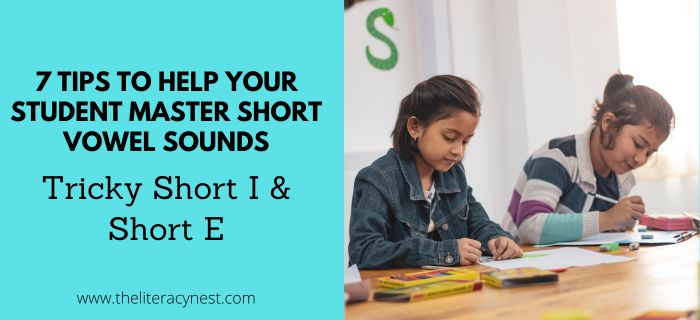Tips for Building Phonemic Awareness in Older Students

You may think of phonemic and phonological awareness as something for the primary grades, for early readers, or for non-readers. If you teach older struggling readers or language arts classes for upper elementary or middle school, you may not find phonemic awareness tasks among the materials at your disposal. However, for a lot of readers who struggle or are reluctant readers, difficulties with phonemic awareness may underlie many of their struggles.
Why it matters?
Phonemic and phonological awareness are key to the development of fluency and automaticity as words that are instantly recognized become part of a reader’s repertoire. It is important not only to continue to teach these skills to students who struggle but to ensure that we are teaching to mastery and automaticity for all students.
What do a student with phonemic awareness struggles look like?
If an older student has a phonological deficit, you may observe certain characteristics. The older reader may struggle with fluency. This reader may appear to read at approximately grade level, but they avoid reading. You often see them referred to as a reluctant reader. You are likely to see spelling struggles with these students as well. Maybe you see them referred to as primarily “sight word readers”.
Where do we start?
Your assessment of older struggling readers is one of your most important tools. Often, these learners are complex and have a tangled web of understandings. Careful assessment can help you untangle this web and find the missing connections. The PAST is an excellent starting place for looking at phonemic awareness. Kilpatrick’s PAST is particularly valuable because it analyzes a student’s automaticity and fluency with these tasks, not just their accuracy. Older students can sometimes complete phonemic awareness tasks backward by using their knowledge of spelling patterns and written words. You may see this in students who are highly accurate with these tasks, but slow. They are likely struggling far more with phonological awareness than you may realize, but they have adapted. Those skills are still very important.
Using an assessment of sounds and words in isolation, particularly one that also assesses nonsense words can be a good way to uncover decoding and encoding difficulties. I like the Gallistel-Ellis test of encoding and decoding. I have assessed many upper elementary reluctant readers who can read and comprehend grade-level material; but are unable to read CVC nonsense words in isolation. They either know a word or don’t know it. They lack the skills to take apart and solve an unknown word.
Your Next Steps
Step 1:
If you have older students who didn’t master phonemic awareness at younger ages still benefit from phoneme manipulation. The window for learning is not closed.
Step 2:
The PAST will identify specific areas of weakness. You can use this assessment to laser focus on those skills most needing practice.
Step 3:
Take a systematic, structured, and sequenced approach to developing phonemic awareness skills. Don’t cherry-pick. Follow your assessments and teach in the order that phonemic awareness skills develop. See Equipped for Reading Success for more information.
Step 4:
Brief, ideally daily, practice is ideal. Quick drills and games done frequently build skills effectively. These are all auditory activities, so no special materials are necessary.
Step 5:
As you introduce new phonemic awareness concepts, make sure to use manipulatives. Even older students love games and benefit from hands-on learning. If your students who are older have struggled with phonemic awareness skills for a long time, you may need to use letters initially to introduce a new concept before moving into using only auditory cueing and manipulatives. Letters should only be a temporary scaffolding step.
Setting 6:
Make a goal of moving into advanced phonemic awareness tasks. These more advanced skills translate to increased fluency and more efficient orthographic mapping.
Looking for more support with your older students? Listen to season 2, episode 4 of the Together in Literacy podcast: How to Effectively Work with Older Students with Dyslexia!
Try These Activities
1. Blending longer words
Segmenting and blending words of 4 or 5 phonemes is a logical extension of blending shorter words. Practice blending with words such as /s//p//l//i//t/ or /p//l//u//m//p/. There is value in using multisyllabic words to strengthen student blending abilities as well. /f//ī//r//t//r//u//k/.
2. Sound chaining
You can use this activity both as a phonemic awareness task with sounds only and manipulatives or as a spelling/phonics activity with letters. For our purposes here, we are focusing on sounds only. Use blocks to show the word cat, change the sound to make it say mat, change the sound to make it say met, let, leg, beg, bed, bid, did, kid, Kim, Tim, tom, top, pop.
3. Words with blends at the beginning or end
This would include segmenting, blending, adding, and deleting phonemes using words with blends. For example, blending the word /c//l//a//p/, or saying /lap/ but adding /k/ to the beginning, or say /clap/ but without the /l/, or saying /clap/ but saying /f/ instead of /k/.
4. Practice with minimal pairs
When we are working with students developing skills, we typically use words that are very distinct from each other. Gradually as their skills improve, we want to include work with minimal pairs. These are words that differ by only one phonemic element such as “cat” and “cap”. This allows us to concentrate on specific phonemes or locations within a word to provide students with targeted practice.
5. Sound deletion
Deleting sounds is easiest at the beginning of a word such as saying mat without /m/, and more challenging at the end of a word such as saying lamp without /p/. Deleting the first or second sound in a blend is more challenging still.
6. Sound reversal
This is an advanced phonemic awareness task that may prove difficult for even some adults. This task asks students to hold a series of sounds in their memory and rearrange them such as to say cat backwards which would be tack or map which would be Pam.
7. Substitute or delete with syllables and/or affixes
Substituting or deleting syllables is an easier task. Substituting and deleting individual phonemes in longer words such as those that contain multiple syllables or affixes can be more challenging. For example, saying sunshine without sun is an easier task. Saying sunshine but instead of shine saying bathe is harder. But saying floating, but instead of /fl/ saying /b/ to get boating, would be more challenging still.
8. The trickiest of all, but super fun, pig Latin
The primary purpose of this activity is to build adeptness with sound play and manipulation. Obviously, pig Latin has limited direct utility for reading and spelling, but it builds flexibility. Words in Pig Latin are formed by removing the onset, saying the rhyme followed by the onset + ay. So the phrase Pig Latin would become igpay atinlay.
Try these Orton-Gillingham Games for Older Students!
Invaluable Resources
So where can you turn for more information about phonemic awareness and older students?
- Equipped for Reading Success by David Kilpatrick is my go-to resource.
- A priceless resource is Heggerty: Bridge the Gap. This curriculum is specifically written to catch up with students who have phonemic awareness deficits.
- Another useful reference is Sounds and Letters for Readers and Spellers by Jane Fell Greene. A critical next step for learners is morphemic awareness.
- To begin to dive into this topic, a great resource is Improving Morphemic Awareness by Sandra Donah.
- The phonological awareness curriculum in my store has a special section for advanced phoneme manipulation tasks.
Are you looking for professional development that will help you better support your students with dyslexia? The Literacy Nest has a membership for that…
Building Readers for Life Academy is a monthly membership program that empowers educators AND families. It dives into structured literacy and strategies for ALL learners. With BRFL Academy, you’ll learn what it takes to help EVERY student become a reader for life.
Join Building Readers for Life Academy today and pay just $1 for your first 30 days! Click here.




